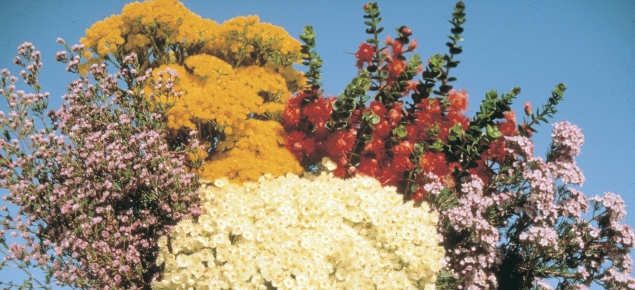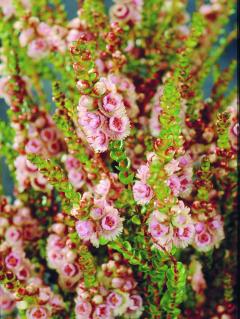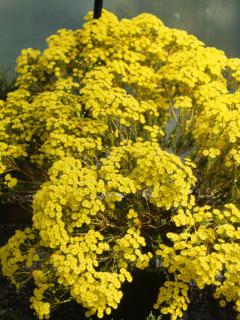Introduction
Verticordias are an extremely diverse group of Australian native flowers. They occur as small shrubs (0.5m) as well as tall plants (2-3m). Flowers of different species can range in diameter from 5 to 25mm. They are hardy plants, often long-lived in their natural environment.
Some only grow a few centimetres per year (e.g. V. eriocephala) forming a dense corymb of flowers while others produce a few long stems in an open branched structure (e.g. V. grandis). A notable feature is that the flowers occur in a range of colours – white, cream, yellow, orange, red and pink. Verticordias are sometimes called 'feather flowers' because of the fringed sepal and/or petal margins and flower receptacle in a number of species.
They are restricted in natural occurrence to Western Australia with three species extending into the Northern Territory (e.g. V. cunninghamii). Different species flower in spring, summer and autumn.
The genus Verticordia is in the family Myrtaceae and closely related to Geraldton wax (Chamelaucium species). There are over 100 species within three subgenera. Verticordia are presently not widely cultivated for the cutflower trade. However, growing verticordias offers the opportunity to have a different flower colour, such as yellow, that does not occur in commercial waxflowers and production of flowers out of the normal wax season such as late spring-summer.
Some 20 species have being picked in Australia for cutflowers, some of which are being cultivated. Four main groups are listed in Table 1.
The special requirements for commercial cutflower production and handling of Verticordia are discussed below.
| Target species | Features | Flower colour | Flowering time | Features as cutflower |
|---|---|---|---|---|
| Light and dark pink small flowers | ||||
| V. plumosa | Feather flowers | Pink | Sept-Nov | Several types, some with terminal globular flower heads |
| V. densiflora | Dense flowers | Pink | Oct-Feb | High yield and long stems, robust plant, long vase life |
| Cupped flower with divided petals, pinks | ||||
| V. pennigera | Toothed petal margin | Deep mauve | Sept-Dec | Long flowering, deep mauve, cupped flowers, long vase life |
| V. luteola var rosea | Fine stems | Pink | Oct-Nov | Fine straight stems, high yield, sensitive to ethylene |
| Round leaf, large flowers arranged in a spike | ||||
| V. fragrans | Perfumed flowers | — | — | Large flowers, high yield, long branching stems, long vase |
| Yellow and orange flowers | ||||
| V. serrata var. linearis | Linear, ciliate leaves | Yellow-gold | Sept-Nov | Long stems, globular flower head, long vase life, sensitive to ethylene |
Main types
Pink, small flowers
Flowers (3-8mm), small leaf types such as V. plumosa and V. densiflora.
Larger, cupped pink flowers
Flowers (10-15mm) and those with highly divided petals and ciliate leaves, including V. pennigera and V. luteola var rosea.
Round or obovate leaf types
These tend to have large flowers (15–25mm), are very showy with flowers packed along a spike and bright colours including V. fragrans.
V. grandis with large red flowers does not appear to yield well in cultivation. V. dichroma var syntoma and V. muelleriana with two-tone flowers are very attractive but tend to have short stems.
Yellow and orange flowers
Small flowered (6-8mm) types include V. serrata which has straight stems with globular heads of yellow flowers giving a good flower display.
V. cooloomia has yellow flowers which tend to mature unevenly on flower heads. V. cooloomia flowers in late spring and is high yielding. The flowers require careful postharvest handling as they are sensitive to ethylene and have a short vase life.
V. chrysantha (yellow) and V. aurea (yellow) have attractive flowers but do not appear to yield well enough in cultivation and V. nitens (orange and yellow) does not appear to yield well in cultivation and is available from natural stands.
Climate
Verticordias are adaptable to a range of rainfall zones from 350 to 850mm and minimum/maximum average temperature from 9/20ºC to 12/25ºC. Verticordia plumosa performs better in moist, cooler regions, while V. fragrans is more suited to the drier, hotter zones provided there is adequate irrigation.
If conditions are too extreme plants may be short lived and stem length may be compromised.
Some species are sensitive to fungal disease especially if warm and moist conditions persist, as often occurs in autumn. In this case vigilance is needed in fungicide spray regimes.



